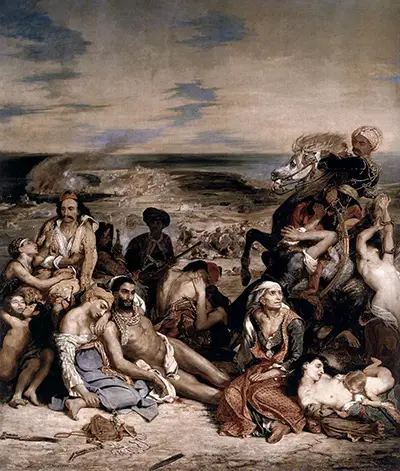The oil painting The Massacre at Chios, exhibited in the Salon of 1824, is the second major work by Eugene Delacroix, the first being Dante and Virgil Crossing the Styx exhibited in 1822.
It was in that year the Ottoman forces attacked the people of Chios and it is the horror and consequent suffering from this event that the painting depicts.
Delacroix is perhaps the most famous representative of the French Romantic movement in the early nineteenth century, a period in which feeling was beginning to dominate the previous ideal of reason.
The painter's fame was due, in part, to the praise lavished on him by the poet Baudelaire who supported the painter's ability to portray the drama of conflict. Delacroix achieved this by using freer brush strokes and a more intense palette than that used by neo-classical artists such as Ingre.
The Massacre at Chios now hangs in The Louvre and is over four metres in height. The background depicts sky, sea and scorched earth and the foreground an attacking mounted soldier and thirteen suffering civilians awaiting their fate.
The people are mostly grouped within two pyramids with the pyramid on the left containing resigned figures including a dying man who stares vacantly and the pyramid on the right dynamic elements such as the rider on his horse and the writhing woman tied to it. The picture is utterly bleak with no redeeming glory as would have been expected in that period.
When The Massacre at Chios was displayed in 1824 at the Salon it was hung in the same room as a painting by Ingre leading to great rivalry and fame. To Delacroix Ingre's colours were just 'icing on a hardbaked cake' and to Ingre The Massacre at Chios was modern art's 'fever and epilepsy'. The painting, despite being called 'the massacre of painting' by Gros whose work Plague of Jaffa Delacroix borrowed from, was bought by the French state for 6,000 francs and transferred to The Louvre in 1874.




